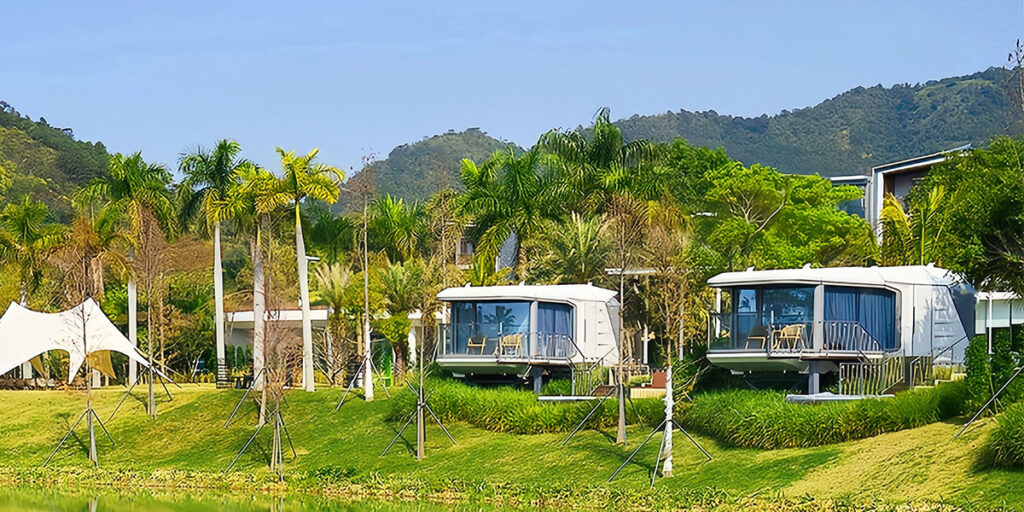
25 Jun What You Should Know About Prefab Capsule House Types
Table of Contents
Prefab capsule houses are small homes made in factories. They are built for quick setup and simple living. Knowing the different types of prefab capsule houses helps you choose the best one for your needs.
Prefab capsule houses have many advantages. They are affordable, simple to build, and good for the environment. Their designs let you change layouts and features, making them useful for different types of purposes.
Key Takeaways
Prefab capsule houses are easy to build and cost less.
Eco-friendly capsule houses use green materials and save energy, helping nature and saving money.
Off-grid capsule homes let you live on your own, great for faraway places and eco-friendly living.
Luxury capsule houses have fancy features and can be customized for comfort and style.
When picking a prefab capsule house, think about design, materials, and rules in your area to choose the right one.
Different Types of Basic Capsule Houses
Features and Design
Basic capsule houses are small, smartly designed, and use space well. These homes often have modular layouts, so you can adjust the inside to fit your needs. The design is simple, with straight lines and a clean look. Most parts are made in factories, with over 90% pre-built. This method speeds up building and cuts down on work at the site.
Capsule houses stand out with creative layouts. They often include furniture that serves multiple purposes, like foldable beds or tables, to save room. The materials are light but strong, making them easy to move and set up. These homes work great in cities where space is tight. Their small size lets them fit in small areas without losing usefulness.
Tip: If you like smart use of space and modern style, a basic capsule house could be a great option for you.
Applications and Use Cases
Basic capsule houses can be used in many ways. Many people choose them as cheap housing in crowded cities. Their small size makes them perfect for places with lots of people. They can also be used as quick housing during emergencies or disasters. Their fast setup means they’re ready to use quickly.
These homes are also great as vacation rentals or guest spaces. Their cool design attracts people who enjoy simple and modern living. Some companies use them as small offices or creative work areas. Their flexible design lets you use them for many purposes, making them useful and handy.
Whether you need a home, a rental, or a workspace, basic capsule houses give you flexible options for different needs.
Different Types of Sustainable Capsule Houses
Eco-Friendly Materials
Sustainable capsule houses use materials that help the environment. They often include bamboo, recycled wood, and other renewable items. Bamboo grows fast and is very strong, making it great for building. Recycled wood cuts down waste and gives old materials a new use.
Some designs add green roofs and vertical gardens. These features keep homes cooler and save energy. They also support small plants and animals, creating tiny ecosystems. 🌱
Did you know? Using eco-friendly materials is why sustainable capsule houses are so popular today.
These homes are not just eco-friendly—they are also useful. Lightweight materials make moving them easier. Strong materials ensure they last a long time. Whether for vacations or daily living, these materials fit eco-conscious lifestyles.
Energy Efficiency Benefits
Saving energy is a key feature of sustainable capsule houses. Many have solar panels to collect sunlight for power. Special heating and cooling systems lower the need for extra energy use.
Small designs help keep heat in during winter and out in summer. This means less energy is wasted. Energy-saving appliances, like fridges and washers, use less power too.
Smart tech is also important. Tools like smart thermostats and lights adjust to your habits. For example, lights turn off when you leave a room, saving energy.
Main energy-saving features include:
Solar panels for clean energy.
Smart thermostats for better temperature control.
Appliances that use less electricity.
Choosing a sustainable capsule house helps the planet and saves money on bills.
These energy-smart designs make sustainable capsule houses a great choice. They mix modern tech with eco-friendly ideas, offering a smart way to live today.
Different Types of Off-Grid Capsule Homes
Self-Sufficient Systems
Off-grid capsule homes work without needing public utilities. These homes use systems to provide water, power, and handle waste. Solar panels turn sunlight into clean energy for electricity. Rainwater systems gather and store water for daily needs.
Many homes have composting toilets and systems to recycle water. These features cut down waste and reuse water smartly. Some designs even add wind turbines to make extra energy.
Tip: Want to live off the grid? Pick homes with systems that suit your lifestyle.
Self-sufficient systems make these homes great for eco-friendly living. You can enjoy modern comforts while helping the planet.
Remote Living Advantages
Off-grid capsule homes are perfect for living in remote places. Their small size and modular design make moving and setting up easy. You can place them in forests, deserts, or mountains for a quiet escape.
These homes give you privacy and freedom. You can avoid noise and enjoy peaceful nature. Many designs have big windows for sunlight and amazing views.
🌄 Fun Fact: Living in nature can lower stress and boost happiness.
Off-grid capsule homes are also great for adventurers. Use them as camps for hiking, camping, or exploring. Their portability and self-sufficient systems make them ideal for remote adventures.
Different Types of Luxury Capsule Houses

High-End Features
Luxury capsule houses make small living feel fancy. They use top-quality materials like marble counters, hardwood floors, and shiny appliances. Smart home systems let you control lights, temperature, and security easily.
These homes often have spa-like bathrooms with rainfall showers and heated floors. Kitchens come with fancy gadgets like coffee makers and wine coolers. Some even include big screens and surround sound for entertainment.
More people now want luxury capsule houses. Wealthy buyers like their mix of style and usefulness. This has led to more high-end designs for those who want comfort and elegance.
Note: If you enjoy modern features and stylish looks, luxury capsule houses are a great choice for fancy, compact living.
Customization Options
Luxury capsule houses can be designed to match your taste. You can pick layouts, materials, and finishes to fit your style. Choose sleek designs for a modern look or warm wood for a cozy feel.
Some models let you add or change rooms, like a home office or guest space. This keeps the design flexible while meeting your needs.
Outdoor spaces can also be customized. Options include rooftop decks, private gardens, or outdoor kitchens. These extras make your home special and improve your living experience.
🌟 Pro Tip: Pick features that match how you live and what you need daily.
Luxury capsule houses combine style and personal touches, making them a top choice among prefab homes today.
Factors to Think About When Picking a Prefab Capsule House
Customization and Size
Think about how much you want to change the design. Some houses let you adjust layouts or add rooms. You can also pick finishes to match your style. For example, you might add a garden or deck outside.
Size matters too. Small capsule houses are good for one or two people. Bigger ones work better for families. Here’s a table comparing costs based on size and customization:
Type of Capsule House | Price per sq. ft. | Average Cost |
|---|---|---|
Prefab capsule house | $100 to $200 | $30,000 to $60,000 |
Custom capsule house | $200 to $350 | $60,000 to $100,000 |
Tip: Want more options? Choose a custom capsule house. It lets you design it your way.
Strong Materials
The materials used affect how long the house lasts. Older prefab homes often needed repairs after 10 years. This meant spending more money over time.
Newer designs use better materials like Econel cement. These materials last longer and need fewer repairs. They also save energy, making them eco-friendly.
Picking strong materials saves money and helps the environment by cutting waste.
Rules and Permits
Check local rules before buying a prefab capsule house. Some places limit where you can put these homes. Others may have size or type restrictions.
You’ll likely need permits to set up your house. Make sure it meets safety and building codes. Researching rules early avoids problems later.
Note: Always ask local officials about zoning rules before buying a prefab capsule house.
Prefab capsule houses come in different types. These include basic, sustainable, off-grid, and luxury designs. Each type has special features. Pick one that fits your lifestyle and needs.
Key Takeaway: Decide if you want eco-friendly, portable, or fancy living.
Make a list of what you need, like size or materials. Check local rules to avoid problems later. Compare choices to find the best mix of cost and features.
Picking the right prefab capsule house gives you a smart home that works for you.
FAQ
What is the average cost of a prefab capsule house?
The price depends on size and type. Basic ones cost about $30,000. Luxury models can go over $100,000. Custom designs and materials also change the cost.
Tip: Look at prices and features to pick one that fits your budget.
Can prefab capsule houses withstand extreme weather?
Yes, many are made with strong materials for tough weather. Some have extra reinforcements for safety. Check the details to ensure it works for your climate.
Do prefab capsule houses require special permits?
Most places need permits for prefab capsule houses. These include zoning and safety approvals. Contact local officials to learn the rules before buying.
Note: Knowing permit rules early can save time and prevent problems.
How long does it take to set up a prefab capsule house?
Setup time depends on the model. Simple ones take a few days. Custom or luxury ones might take weeks. Factory pre-building makes the process faster.
Are prefab capsule houses eco-friendly?
Many use green materials and energy-saving systems. Solar panels, rainwater systems, and smart devices help the environment.
🌱 Fun Fact: Eco-friendly capsule houses cut your carbon footprint and save money on bills.



